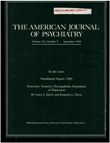The dexamethasone suppression test: identification of subtypes of depression
Abstract
In this study mean 4 p.m. cortisol levels were significantly higher in patients with major depression than in control subjects or in patients with bipolar depression or dysthymic-related disorders. Moreover, the distribution of values differed significantly among groups. Eighteen of 45 patients with major depression had cortisol levels of 10 micrograms/dl or more, compared with 2 of 20 bipolar depressed patients and 0 of 31 controls. Patients with very high cortisol levels (15 micrograms/dl or more) tended to fulfill criteria for major depression with mood-congruent psychosis. The distribution of values in the major depression group also suggested the existence of three major subgroups. The authors discuss the implications of these data.
Access content
To read the fulltext, please use one of the options below to sign in or purchase access.- Personal login
- Institutional Login
- Sign in via OpenAthens
- Register for access
-
Please login/register if you wish to pair your device and check access availability.
Not a subscriber?
PsychiatryOnline subscription options offer access to the DSM-5 library, books, journals, CME, and patient resources. This all-in-one virtual library provides psychiatrists and mental health professionals with key resources for diagnosis, treatment, research, and professional development.
Need more help? PsychiatryOnline Customer Service may be reached by emailing [email protected] or by calling 800-368-5777 (in the U.S.) or 703-907-7322 (outside the U.S.).



